Resnick & Halliday Solutions for Chapter: Interference, Exercise 1: Problems
Resnick & Halliday Physics Solutions for Exercise - Resnick & Halliday Solutions for Chapter: Interference, Exercise 1: Problems
Attempt the practice questions on Chapter 35: Interference, Exercise 1: Problems with hints and solutions to strengthen your understanding. Principles Of Physics International Student Version solutions are prepared by Experienced Embibe Experts.
Questions from Resnick & Halliday Solutions for Chapter: Interference, Exercise 1: Problems with Hints & Solutions
Reflection by thin layers. In the figure below, light is incident perpendicularly on a thin layer of material that lies between (thicker) materials and (The rays are tilted only for clarity.) The waves of rays and interfere and here we consider the type of interference to be either maximum (max) or minimum (min). For this situation, each problem in table refers to the indexes of refraction and the type of interference, the thin-layer thickness in nanometers, and the wavelength in nanometers of the light as measured in air. Where is missing, give the wavelength that is in the visible range. Where is missing, give the second least thickness or the third least thickness as indicated.
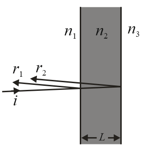
Transmission through thin layers. In the figure given below light is incident perpendicularly on a thin layer of material that lies between (thicker) materials and (The rays are tilted only for clarity.) Part of the light ends up in material as ray (the light does not reflect inside material ) and (the light reflects twice inside material ). The waves of and interfere and here we consider the type of interference to be either maximum (max) or minimum (min). For this situation, each problem in the table refers to the indices of refraction and the type of interference, the thin-layer thickness in nanometers, and the wavelength in nanometers of the light as measured in air. Where is missing, give the wavelength that is in the visible range. Where is missing give the second least thickness or the third least thickness as indicated.
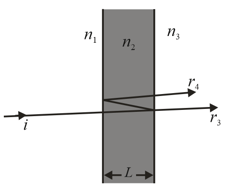
Figure a shows a lens with radius of curvature lying on a flat glass plate and illuminated from above by light with wavelength . Figure b (a photograph taken from above the lens) shows that circular interference fringes (known as Newton's rings) appear, associated will une variable thickness d of the air film between the lens and the plate. Find the radii of the interference maxima assuming
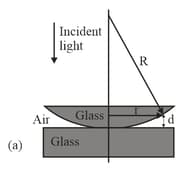
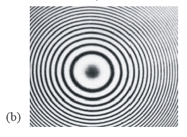
A Newton's ring apparatus is to be used to determine the radius of curvature of a lens (see figure). The radii of the and bright rings are found to be and respectively, in light of wavelength . Calculate the radius of curvature of the lower surface of the lens.
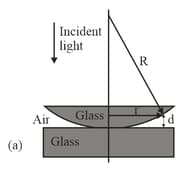
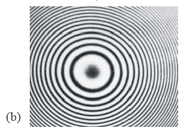
If mirror in a Michelson interferometer is moved through , a shift of bright fringes occurs. What is the wavelength of the light producing the fringe pattern?

The figure shows two isotropic point sources of light and that emit in phase at wavelength and at the same amplitude. A detection point is shown on the -axis that extends through source . The phase difference between the light arriving at point from the two sources to be measured as is moved along the -axis from to . The results out to are given in figure on the way out to . What is the greatest value of at which the light arriving at from is exactly out of phase with the light arriving at from ?
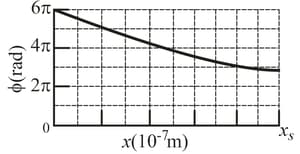
In the figure, two radio-frequency point sources and , separated by distance, , are radiating in phase with . A detector moves in a large circular path around the two sources in a plane containing them. How many (a) maxima and (b) minima does it detect?

In the figure, two isotropic point sources and emit identical light waves in phase at wavelength . The sources lie at separation on the -axis and a light detector is moved in a circle of large radius around the midpoint between them. It detects points of zero intensity including two on the -axis, one of them to the left of the sources and the other to the right of the sources. What is the value of ?

